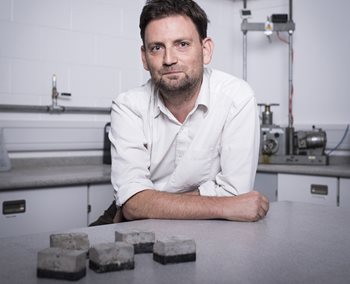Self-healing concrete
“If it cracks, bacteria are released and form limestone to seal it”

The extraordinary thing about the lump of concrete on Dr Kevin Paine’s desk is that it looks entirely normal. But this concrete used to be cracked – and it has mended itself. “I used to be able to see where the cracks had been,” says Paine, reader at Bath University’s civil engineering department and a leading researcher in the field of self-healing concrete. “But the fine white ‘scars’ have faded and now I can barely make them out.” So how is it done?
Paine explains that the cracks have been filled with calcium carbonate precipitated by bacteria living in the concrete. “We add bacterial spores to the concrete mix along with food such as yeast extract. If the concrete cracks, the bacteria are released and exposed to oxygen and water. They feed on the yeast, they multiply, and as a result of metabolic actions, calcium carbonate – or limestone – forms to seal the crack before it has a chance to enlarge.” Paine’s interest in self-healing concrete dates from a trip to Delft in Holland in 2011 where researchers were among the first to try the technique.
“To begin with it was a bit over my head,” he admits. “I am a civil engineer and I didn’t know much about bacteria. But I came back to Bath, talked to the microbiologists here and we agreed we could take it forward. Better still, researchers in other forms of self-healing concrete (vascular systems, for example) at Cardiff and Cambridge universities also took an interest and together we were able to secure grant funding to pursue our research.” Getting it to work well has not been straightforward: “The spores have to survive the mixing process,” says Paine. “We can encapsulate them, but any coating has to be brittle enough to fracture and release the ingredients when the concrete cracks.”
Trials are ongoing – as evidenced by the calcite-flecked Petri-dishes in the biology labs. “We have now got to the stage where we have mixes that work reliably,” says Paine. “Small cracks will be repaired within about 14 days. Our problem now is that this works best at around 20°C or higher and in wet conditions. That might be OK for monsoon regions, but obviously we need to get it to work at much lower temperatures – hence the fridges in which we are testing our latest mixes.”
This is truly groundbreaking stuff. “What we know about bacteria tends to come from medicine – so we know plenty about how bacteria behave at body temperature. How they operate at, say, 5°C we just have to find out for ourselves.”
Words by Tony Whitehead
Photo Paul Burroughs
Published in CQ Winter 2019